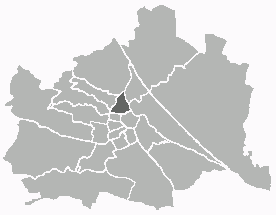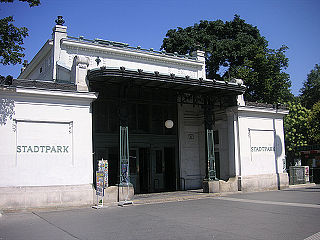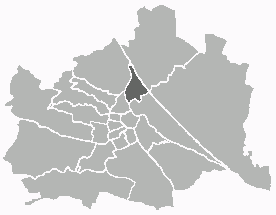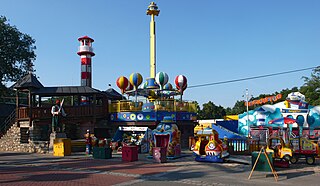
Alsergrund is the ninth district of Vienna, Austria. It is located just north of the first, central district, Innere Stadt. Alsergrund was incorporated in 1862, with seven suburbs. As a central district, the area is densely populated. According to the census of 2001, there were 37,816 inhabitants over 2.99 square km.

Leopoldstadt is the 2nd municipal district of Vienna in Austria. As of 1 January 2016, there are 103,233 inhabitants over 19.27 km2 (7 sq mi). It is situated in the heart of the city and, together with Brigittenau, forms a large island surrounded by the Danube Canal and, to the north, the Danube. It is named after Leopold I, Holy Roman Emperor. Due to its relatively high percentage of Jewish inhabitants before the Holocaust, Leopoldstadt gained the nickname Mazzesinsel. This context was a significant aspect for the district twinning with the New York City borough Brooklyn in 2007.

Meidling is the 12th district of Vienna. It is located just southwest of the central districts, south of the River Wien, west of the Gürtel belt, and east and southeast of Schönbrunn Palace. Meidling is a heavily populated urban area with many residential buildings, but also large recreational areas and parks. In sports, it is represented by the FC Dynamo Meidling. Former Chancellor of Austria Sebastian Kurz was born and raised in Meidling and his private residence is there.
Schweizer Radio: Radio der deutschen und rätoromanischen Schweiz was a company of SRG SSR which operated the public German-language radio stations of Switzerland from 1931 until 2012.

The Stadtpark in Vienna, Austria is a large municipal park that extends from the Ringstraße in the Innere Stadt first district up to the Heumarkt in the Landstraße third district. The park is divided in two sections by the Wienfluss, and has a total surface area of 65,000 square metres. Scattered throughout the park are statues of famous Viennese artists, writers, and composers, including Hans Canon, Emil Jakob Schindler, Johann Strauss II, Franz Schubert, and Anton Bruckner. The opulent Kursalon building on Johannesgasse, with its broad terrace that reaches into the park, is the site of popular waltz concerts.

The Wiener Riesenrad, or simply Riesenrad, is a 64.75-metre (212 ft) tall Ferris wheel at the entrance of the Prater amusement park in Leopoldstadt, the 2nd district of Austria's capital Vienna. It is one of Vienna's most popular tourist attractions, and symbolises the district as well as the city for many people. Constructed in 1897, it was the world's tallest extant Ferris wheel from 1920 until 1985.

Ernst-Happel-Stadion, known as Praterstadion until 1992, sometimes also called Wiener-Stadion, is a football stadium in Leopoldstadt, the 2nd district of Austria's capital Vienna. With 50,865 seats, it is the largest stadium in Austria. It was built between 1929 and 1931 for the second Workers' Olympiad to the design of German architect Otto Ernst Schweizer. The stadium was renamed in honour of Austrian footballer Ernst Happel following his death in 1992. The stadium hosted seven games in UEFA Euro 2008, including the final which saw Spain triumph over Germany.

Donaustadt is the 22nd district of Vienna, Austria . Donaustadt is the eastern district of Vienna.

Brigittenau is the 20th district of Vienna. It is located north of the central districts, north of Leopoldstadt on the same island area between the Danube and the Danube Canal. Brigittenau is a heavily populated urban area with many residential buildings.

The Wurstelprater is an amusement park and section of the Wiener Prater in Leopoldstadt, Vienna, Austria.

The Leopoldstädter Tempel was the largest synagogue of Vienna, in the district (Bezirk) of Leopoldstadt. It was also known as the Israelitische Bethaus in der Wiener Vorstadt Leopoldstadt. It was built in 1858 in a Moorish Revival style by the architect Ludwig Förster. The tripartite facade of the Leopoldstädter, with its tall central section flanked by lower wings on each side, became the model for numerous Moorish Revival synagogues, including the Choral Temple in Bucharest, which has an almost identical main facade, the Zagreb Synagogue, the Spanish Synagogue in Prague, the Tempel Synagogue in Kraków and the Grand Synagogue of Edirne.

The Prater is a large public park in Leopoldstadt, Vienna, Austria. The Wurstelprater, an amusement park that is often simply called "Prater", lies in one corner of the Wiener Prater and includes the Wiener Riesenrad Ferris wheel.

Palais Augarten is a Baroque palace in the district of Leopoldstadt, Vienna, Austria. Constructed in the late seventeenth century by Johann Bernhard Fischer von Erlach on the site of a Jagdschloss and gardens, the palace and gardens were expanded in the nineteenth century under Emperor Franz Joseph I of Austria. Despite extensive damage suffered during World War II, the palace has been maintained almost in its original appearance, and many of the original furnishings can still be found there. Today, Palais Augarten is the home and rehearsal space of the Vienna Boys' Choir, who also have their own school there. The palace is located in the 130-acre Augarten park, which is the oldest Baroque garden in Vienna.

The Donaukanal is a former arm of the river Danube, now regulated as a water channel, within the city of Vienna, Austria. It is 17.3 kilometres (10.7 mi) long and, unlike the Danube itself, it borders Vienna's city centre, Innere Stadt, where the Wien River (Wienfluss) flows into it.

The Bohemian Prater is a small amusement park at the edge of Vienna, in Favoriten, Vienna's 10th district. It dates to the second half of the 19th century, and some of the rides are more than 100 years old. The name is derived from the larger Wiener (Viennese) Prater in Vienna's Leopoldstadt (2nd) district.

The Augarten is a public park of 52.2 hectares situated in the Leopoldstadt, the second district of Vienna, Austria. It contains the city's oldest Baroque park.

The Prater Liliputbahn is a 381 mm gauge light railway in Vienna, Austria. Opened in 1928, and extended in 1933, the railway operates primarily as a tourist attraction, but also provides transport links around the wider area of the Prater park, the amusement park (Wurstelprater), and the sports stadium. Although a year-round service was provided for many years, it is now more common for the railway to close during the months of December, January, and February. Originally steam-operated, the railway now uses a mixture of steam and diesel motive power. The railway can be reached by bus, tram, or metro from central Vienna, followed by a short walk, but following the extension of tram line 1, there is now an almost direct interchange with the Vienna tram network at the railway's Rotunda Station.
The history of the Jews in Vienna, Austria, goes back over eight hundred years. There is evidence of a Jewish presence in Vienna from the 12th century onwards.

The Lusthaus is a historic building in Prater park in the Leopoldstadt district of Vienna, Austria. It is located at the southeastern end of Prater Avenue, near the Freudenau racecourse.

















